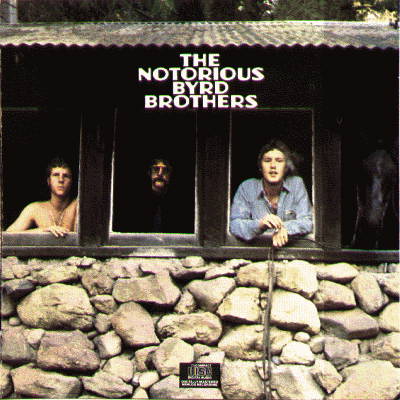 |
From the Vault...
07/02/2017
#1575 |

|
info
The Byrds
"The Notorious Byrd Brothers"
© Columbia < Records
Rating:


|
track listing
|
Artificial Energy
Goin' Back
Natural Harmony
Draft Morning
Wasn't Born To Follow
Get To You
Change Is Now
Old John Robertson
Tribal Gathering
Dolphins Smile
Space Odyssey
|
WSVNRadio Archives
The Byrds related sites:
|
|
|
The Byrds
"The Notorious Byrd Brothers"
The Byrds' 1968 release The Notorious Byrd Brothers presented a different direction for the band. Two previous members had left the band:
David Crosby was fired, and Michael Clarke left midway through the recording of the album. Also, another member had left, Gene Clark. Although
all three members had participated on various recordings on the album, their existence in the band were no more.
The album took a different direction in the band's music. By 1968, psychedelic music had been popular, and not only did the Byrds incorporate
the "new sound," they also experimented in folk rock (which was the band's primary sound), country, electronic, baroque pop, and jazz. After listening
to the album, it was more on the levels of Psychedelic, Folk, and Country.
"Artificial Energy" has the energy; being very upbeat, and definitely not folk, yet almost psychedelic, as the experimentation of this music
was developing. "Goin' Back" has the previous Byrds' sound from previous albums, yet the experimentation continued with the song sounding
Country'ish.
More on the psychedelic level are "Natural Harmony" and "Draft Morning." These songs were compared to a more popular psychedelic
song that the Byrds recorded from their previous album, 5th Dimension, the classic "Eight Miles High." "Wasn't Born To Follow"
you would think was penned by Bob Dylan, as it has the familiar folk style the Byrds were famous for. This song was not written by Dylan, it was written
by Carole King and Gerry Goffin -- they had also written "Goin' Back." As previous Byrds' albums featured many songs written by Dylan, there were
no songs on this album, written by him on this release.
As the Byrds were experimenting and becoming different, it is heard on the folkish-yet-different "Get To You" and "Change Is Now."
(Definitely "a change" was becoming the focus for the band's music.) As they experimented with Country, "Old John Robertson" sounds Country'ish,
with it's fancy string arrangements. And, for those who could label another band's music as "Country," I can't help but compare this song, and of some
others too, to that of the Grateful Dead.
More on the "different level," is the psychedelic "Tribal Gathering. And again, mentioning how the different direction in the band's music,
it is heard on the remaining two tracks, "Dolphins Smile" and "Space Odyssey."
By the end of the 1960s, Rock music was developing into different sounds, mostly psychedelic. The "Country sound" of the Byrds here was just the
start of something that would become much bigger in the 1970s. With not only regular Country, but what was labeled as "California Rock" with bands and
artists, such as The Eagles, Jackson Browne, Linda Ronstadt. And another artist, Gram Parsons, who would become a huge participant on the Byrds' next
album, Sweetheart of the Rodeo. Call it "Country Rock," this would become another huge sound during the 1970s decade. Parsons and Byrd members
Chris Hillman and Michael Clarke would leave the Byrds, and in 1969, they would form the Flying Burrito Brothers.
The Notorious Byrd Brothers was a different direction for the Byrds, as it would be one of their finest albums. It was the beginning stages
of "Country Rock" in its full glory. Although the three Byrd members mentioned had left, their involvements were represented on the album: David
Crosby had co-written "Draft Morning," "Tribal Gathering," and "Dolphins Smile." Gene Clark cor-wrote "Get To You." Drummer
Michael Clark played drums on 5 of the original 11 tracks. The album cover only shows three band members, and a horse. Pictured (from left to right)
were Chris Hillman, Roger McGuinn and Michael Clarke. Although Clarke had been around long enough to participate (after all, he did play drums on 5 of
the 11 original tracks), Crosby had been fired from the band, yet he particpated and co-wrote songs for the album. On the album cover he was [supposedly]
replaced by a horse. The three band members had posed on horseback during the cover session with photographer Guy Webster. Afterwards, they lined up in
the windows of a stone house/stable, located at California's Topanga Canyon, where more photographs were taken. As Webster explained: "I get asked
about this cover shot for the Byrds all the time. The group was going through changes. I got a call to shoot the album cover. They wanted to go out to
the country, since their first album cover was shot in a studio. So I found this abandoned barn with four open windows. There was a horse in the field.
I put each one of the guys in the windows. And in the last window I put the horse. I was mistakenly accused of denigrating David Crosby. It wasn't
to replace Crosby, who had been fired; it wasn't to insult anyone. It was just to balance the composition. It was just a space and a horse -- and what
an image."
A different direction. A change in musical style. The beginning of another huge impact in Rock music. Did the Byrds start it all off for the
upcoming decade? That I'm not exactly sure, but it did influence the many who would become popular in the 1970s decade.
© WSVNRadio.net. All rights reserved.
Review or any portion may not be reproduced
without written permission. Cover art is the
intellectual property of
Columbia Records
and is used for reference purposes only.
|
|




